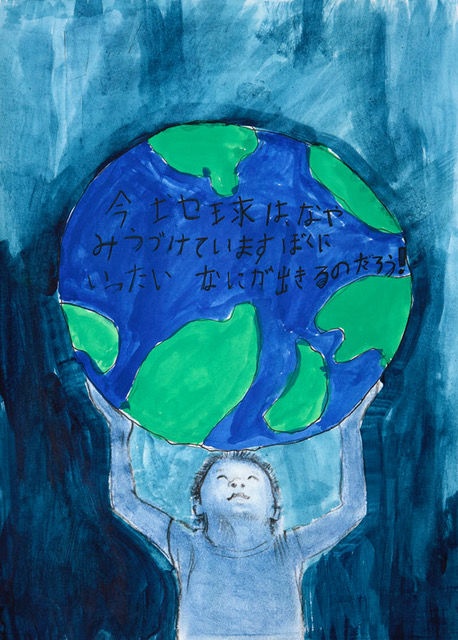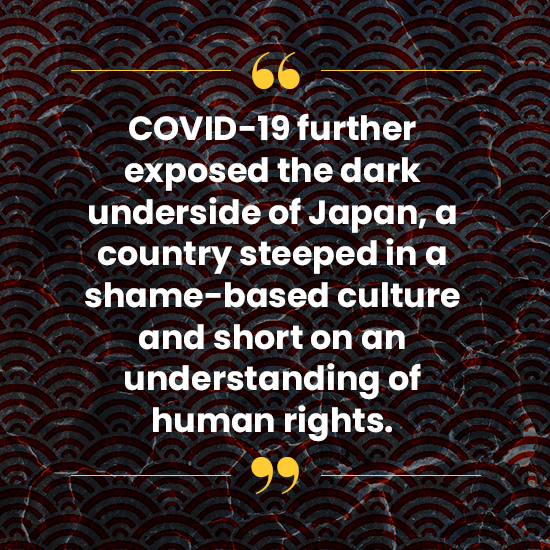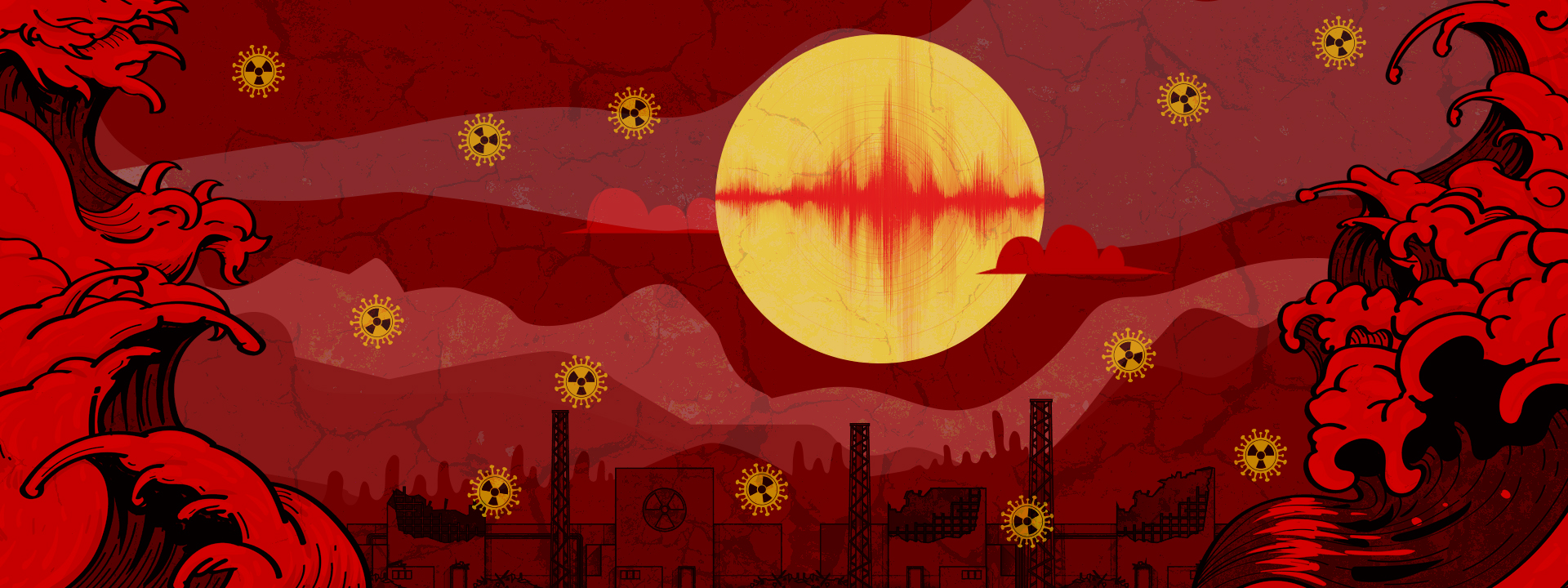In March 2021 it will have been 10 years since the Fukushima nuclear disaster broke out in Japan. But 43,000 people are still registered as official nuclear evacuees, excluding many that remain uncounted. The human rights of nuclear victims have been violated by the government, the operator of the damaged nuclear plant, and a society that blames victims. The state and its partners’ attitude throughout many public emergencies seems to put all responsibility on the shoulders of the victims, and the COVID-19 pandemic has seen this approach applied yet again.
[dropcap font=”Times New Roman” size=”110px” background=”” color=”” circle=”0″ transparent=”0″]O[/dropcap]n March 11, 2011, a magnitude 9.0 earthquake struck Japan’s north-eastern Tohoku region, setting off a cascade of catastrophes, the aftershocks of which can still be felt up to this day.
The Great East Japan Earthquake, as it would come to be popularly called, is the strongest ever in the country’s history, and is the fourth most powerful in the world in modern times. It would push Honshu, Japan’s main island, some two meters away, and its force would be enough to nudge the entire planet off its spin by a couple of centimeters.
But the earthquake’s effects would not end there.

Originating deep beneath the waves, the earthquake set in motion towering walls of water that slammed into the Japanese mainland, drowning thousands and leaving drenched wreckage in its wake. Hundreds of aftershocks followed the main quake, dozens of which were above magnitude 6.0, and several were stronger than magnitude 7.0.
By some reports, water from the tsunamis reached even up to 10 kilometers inland. For the Fukushima prefecture, which sits right at the mouth of the sea, it was impossible to avoid the deluge. Critically, Fukushima was also home to a number of nuclear power plants.
As soon as the tremors started, safety mechanisms at these powerplants were triggered, shutting down the reactors that were active at the time. This also cut off the main power to the plants, but back-ups were in place and they were enough to keep the emergency cooling systems going.
About an hour after the earthquake, the Fukushima Daiichi Nuclear Powerplant, once among the world’s fifteen largest, was inundated, disabling almost all of its emergency back-up power. Unable to cool itself down, the three reactors overheated, leading to meltdowns, fires, and explosions.
In the coming days, the Powerplant’s radioactive motherlode would leak out and up, tainting the entire prefecture. The Fukushima nuclear disaster would eventually be classified as a Level 7 incident on the International Nuclear Event Scale, the only one in history to ever rival the 1986 Chernobyl disaster.
A blueprint for human rights neglect
In the days that followed the disaster, authorities scrambled to clean up the mess, but even in the confusion and chaos, it soon became clear that there was a difference in priorities.
Where foreign governments strove to evacuate their citizens from Fukushima—and out of Japan—some even chartering aircraft, the Japanese government seemed to be more interested in keeping up appearances. They hid information about the radioactive plume that covered Fukushima.
“Radiation will have no immediate effect on your health,” came the constant announcements from the central government. There had been no distributions of medical potassium iodide—to help protect the thyroid from radioactive attack—and evacuation zones were made as small as possible, sending a fatally wrong message to the public.
In a 2018 study by Kyushu and Manchester Universities, researchers found that micro-particles were at much higher concentrations than expected even kilometers away from the power plants. Back in Fukushima, meanwhile, people, including women and children who didn’t know any better, lined up for food and water outside, under the radioactive fallout.
Unsurprisingly, the radiation would soon take a dangerous toll on bodies. Mothers would find radioactive cesium isotopes in their breastmilk and, more troublingly, researchers would report the same substances in placenta, its radioactivity seeping across generations. There have already been reports of cesium being detected in the urine of kids.
Since 2011, the prefecture of Fukushima has monitored the thyroid of children under 18 years who were present at the time of the disaster. While childhood thyroid cancer is usually a rare occurrence, 240 official cases have already been reported in Fukushima, and 314 are receiving financial support.
On top of this, thyroid cancers diagnosed by other hospitals, and those detected after families have evacuated, are excluded from the official tally. In many cases, the malignancy has already spread to other parts of the body and develops abnormally quickly.
As a means of recourse, victims, their lawyers, and concerned citizens continue to fight for justice and to seek assurance that such a disaster will never happen again. So far, over 12,000 Fukushima victims have filed 30 cases against the government and the Tokyo Electric Power Company (TEPCO). Theirs is a steeply uphill battle, however.
Seven district courts have found that the government has a responsibility for the victims and in September 2020, the Sendai High Court confirmed that the state was responsible for the incident.
But the government will not budge and has since appealed the Sendai decision to the Supreme Court. Their tactic is to delay. Stall for as long as they can and wait for the victims to grow old and die. Delay verdicts, delay actions, deny justice.
Meanwhile, as the cases snake slowly through the courts, the Japanese government would eventually lift most of the evacuation zones in 2017 and by 2019, would terminate housing support. They also keep health data under tight control, refusing access by the public. More and more, the Fukushima disaster is seeming like an officially closed case, and victims of the nuclear disaster are slowly running out of options but to return to their ground zero.
COVID-19 and the individualization of responsibility
During the immediate aftermath of Fukushima, Japanese mothers had it extremely tough. Aside from having to deal with the nuclear fallout, they also got piled on by Western media, blamed for worrying about their children too much. This—the excessive stress—so the pontifications went, was the most noxious side effect of the disaster.
Sickness, unemployment, family conflict, severe financial hardship, distress, and the destruction of local communities. Suddenly, all were because of individual shortcomings, instead of obvious byproducts of state neglect.
 Nine years later, as the world buckles under the COVID-19 pandemic, this sleight of hand in responsibility would again play out in the most sinister of ways.
Nine years later, as the world buckles under the COVID-19 pandemic, this sleight of hand in responsibility would again play out in the most sinister of ways.
COVID-19 further exposed the dark underside of Japan, a country steeped in a shame-based culture and short on an understanding of human rights. People who end up getting infected with COVID-19 get no sympathy, but are blamed and criticized: Surely, the only explanation for their illness is their own carelessness.
In response to the outbreak, the government has stayed away from strict lockdowns, but has instead banked on individual precaution. Japanese prime minister Yoshihide Suga announced that self-help is the priority, mutual assistance is next, and public assistance comes last.
This has left thousands of workers to fend for themselves. In a recent opinion poll by NHK, 24 percent of respondents said their income was lower due to the pandemic. Many temporary workers and part-timers, women in particular, have also lost their jobs.
For homeless people, the problems are even worse. With the declaration of a state of emergency, internet cafés were forced to close, and with it, thousands of people who rely on them for accommodations—the so-called net café refugees—were left out on the streets.
Tsuyoshi Inaba, a homeless support activist, said he and the group he leads have been trying to extend help to these refugees in the absence of official assistance, but there’s only so much that they can do. “Already this is beyond the level that can be solved by self-help efforts,” he says. “The theory of self-responsibility to avoid giving trouble to people is driving rough sleepers into a critical situation.”
There are few measures in place for people whose economic and living situations were made worse by the pandemic. COVID-19 has accelerated poverty and exacerbated inequality in Japan in the same ways as the Fukushima disaster has.
Nine years, thousands of lives, and billions of dollars later, it seems that the most crucial lessons still have yet to be learned. ●
Mitsuko Sonoda was living in Fukushima with her family at the time of the nuclear disaster. As a Fukushima campaigner, she has delivered speeches at the United Nations Human Rights Council and the UN Environment Programme about how the victims’ human rights have been violated in the aftermath of the disaster.
















